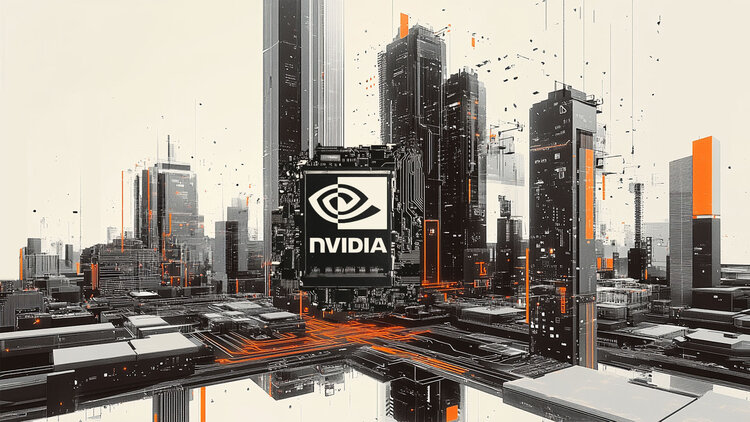Key points
- Nvidia’s earnings and long-term vision have reignited the AI narrative, signaling the arrival of AI 2.0—driven by reasoning AI, Agentic AI, and growing sovereign demand.
- The AI investment opportunity is expanding beyond Nvidia, with second-order beneficiaries emerging across semiconductors, data infrastructure, enterprise software, cybersecurity, and sovereign AI systems.
- Key risks include geopolitical uncertainty, high valuations, and rising competition, particularly from alternative chip suppliers and national efforts to build self-sufficient AI ecosystems.
Nvidia’s latest earnings weren’t just a strong quarter—they were a strategic inflection point for the AI trade. Despite a $4.5 billion China-related inventory writedown, the company reported a 69% YoY jump in revenue and delivered a bold vision for the AI economy.
More importantly, CEO Jensen Huang laid out the architecture for what he calls the next phase of the AI revolution. For investors, this isn’t just about one stock. It’s a wake-up call that AI is entering a deeper, more structural phase—and opportunities are broadening.
While Nvidia remains the central force driving AI infrastructure demand, the company’s blowout quarter is also lifting expectations for second-order beneficiaries—firms that supply, support, or scale AI deployment.
Nvidia’s AI 2.0 playbook
Huang identified several key drivers that will shape AI demand over the next decade:
1. Reasoning AI
AI is evolving from generating outputs to executing multi-step logic and decision-making. Nvidia’s Blackwell architecture is designed for this leap, with higher memory and faster compute tailored to complex use cases.
2. Agentic AI
Huang described this as game-changing. Agentic AI refers to autonomous systems that can plan, act, and iterate on their own—moving beyond assistance into initiative. This represents a significant step-up in compute intensity.
3. Enterprise AI
Corporates are integrating AI into core operations—from logistics and finance to healthcare—transforming AI into a long-term capital expenditure cycle.
4. Robotics, industrial AI & factory automation
AI-driven intelligence is now being embedded into manufacturing—from predictive maintenance to robotic workflows—driving demand for edge computing and real-time analytics.
5. Sovereign AI buildouts
AI demand is no longer limited to hyperscalers. Governments, telecoms, and regional cloud providers are building sovereign infrastructure, diversifying both demand and deployment.
Investment themes and implications beyond Nvidia
While Nvidia remains the epicenter, the AI boom is widening—and so is the investment opportunity set:
Semiconductors and chip infrastructure
As AI models become more complex and widespread, demand is rising not only for compute power but also for the surrounding chip ecosystem.
- Advanced Micro Devices (AMD) and Broadcom are key alternatives to Nvidia, providing AI accelerators and networking chips.
- Marvell Technology supports the AI data pipeline with high-speed interconnect and custom silicon.
- TSMC and ASML remain foundational players in the production of next-generation AI chips, powering both Nvidia and its competitors.
- At the same time, Chinese tech giants Alibaba, Tencent, and Baidu are reportedly testing alternatives to Nvidia’s hardware—including in-house solutions and AI semiconductors from Huawei Technologies. This underscores a growing trend toward AI self-sufficiency in China, with implications for both global chip demand and geopolitical dynamics.
Data center and power infrastructure
AI training and inference require massive energy and hardware infrastructure. This is creating tailwinds for companies enabling the physical expansion of data centers.
- Super Micro Computer (SMCI) builds AI-optimized servers using Nvidia GPUs and stands to gain from hyperscale and enterprise buildouts.
- Vertiv Holdings provides cooling and power infrastructure for AI data centers—an essential link as compute density rises.
Software and enterprise automation
The rise of Agentic AI and enterprise AI adoption is fueling demand for software that orchestrates, secures, and manages intelligent workflows.
- Palantir (PLTR) supports data intelligence and model deployment across government and enterprise clients.
- ServiceNow (NOW) is expanding its AI footprint through workflow automation for large enterprises.
Cybersecurity
As AI adoption scales, so do risks—making cybersecurity a vital enabler of the next phase of growth. From securing AI models to protecting sovereign data stacks, the sector is increasingly mission-critical.
- CrowdStrike (CRWD) and Palo Alto Networks (PANW) offer next-gen security platforms tailored to cloud and AI environments.
- Zscaler (ZS) provides secure access for distributed AI workloads and edge deployments.
Sovereign AI infrastructure
As countries accelerate their push for data independence and AI leadership, sovereign AI infrastructure is emerging as a major investment theme. Governments and regional cloud providers are building secure, localized systems to support national security, research, and industrial policy goals. Bank of America estimates sovereign AI could represent 15% of annual global AI infrastructure spending in the near future, equating to a $50 billion opportunity each year. This shift supports demand for secure, localized infrastructure.
- Dell Technologies (DELL) has secured a landmark contract to build NERSC-10, the U.S. Department of Energy’s next-generation supercomputer, powered by Nvidia’s Vera Rubin platform. It is also expanding sovereign AI capacity across MENA.
- Oracle (ORCL) is increasingly positioning its Oracle Cloud Infrastructure (OCI) as a secure, compliant AI platform for regulated and sovereign use cases, gaining traction with governments and large enterprises seeking data residency.
- Cisco Systems (CSCO) has partnered with Middle Eastern governments to deliver secure AI cloud infrastructure, making it a quiet but meaningful player in sovereign AI.
Risks to monitor
- Geopolitical uncertainty: Export controls, especially involving China, may continue to disrupt supply chains and access to key markets.
- Valuation pressure: AI leaders are priced for perfection. Any sign of demand plateauing or delays in adoption could trigger volatility.
- Rising competition: While Nvidia leads, AMD and custom silicon (e.g., from hyperscalers) are closing the gap.
Read the original analysis: AI 2.0 is here: Nvidia’s blowout earnings reinforce the case for long-term exposure

